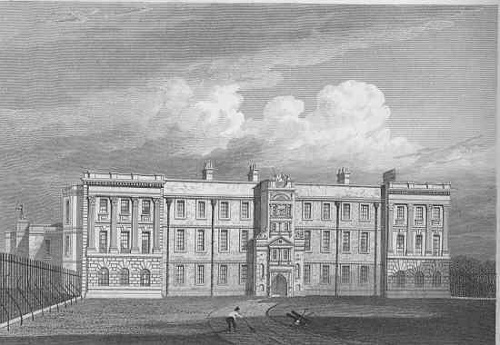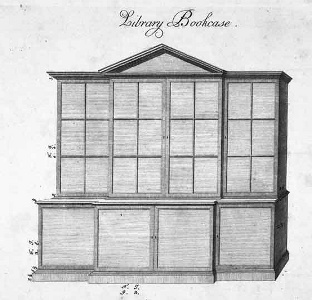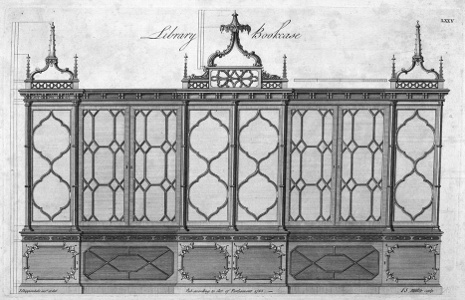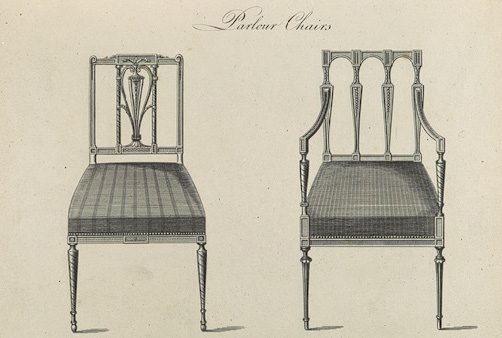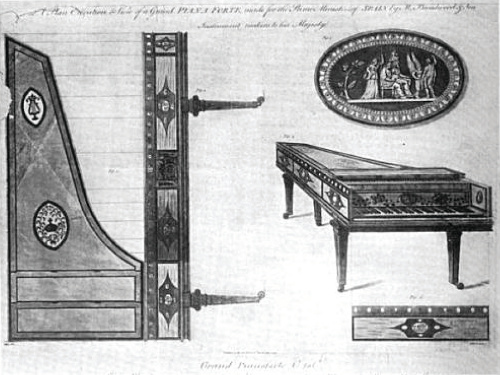|
Although Wickham has given Mrs. Gardiner a “minute description” of Pemberley (143), and the housekeeper Mrs. Reynolds speaks about the “subject of the pictures, the dimensions of the rooms, and the price of the furniture” during her tour for Elizabeth Bennet and the Gardiners (249), the narrator of Pride and Prejudice supplies only the slightest details about the architectural features, the rooms, and the furnishings. By the time Elizabeth visits Pemberley, having seen Rosings, Chatsworth House, and Blenheim Palace, “she was tired of great houses; after going over so many, she really had no pleasure in fine carpets or satin curtains” (240). Yet her recent viewing of impressive homes allows her to make an informed evaluation of Pemberley. Moreover, even the scant details provided about the exterior and interior design choices made by Mr. Darcy and his ancestors reflect the excellence of his character.
The reader is given an account of Pemberley’s picturesque grounds when Elizabeth first sees them, but the building itself does not elicit much description by Austen; the house and rooms are merely handsome, large, well-proportioned, lofty, spacious, and pretty (245, 246, 250). Susan Watkins has suggested that a widespread appreciation for and knowledge about decorative arts and architecture among both the elite and middle classes during Austen’s lifetime made description of them in her novels unnecessary (88). The period was one of exceptional artistry and refinement in architecture, furniture, and design. Owners of country homes had access to a great number of professional architects and decorators. Simultaneously, there was an increase in the choice of furniture and accessories. The wealthy sought to impress guests with their good taste, expensive possessions, and modern amenities, and they updated the furnishings of their houses with the newest styles (Yorke chs. 1, 5). Both Mr. Darcy and his sister are active participants in decorating: Caroline Bingley mentions Georgiana’s “‘beautiful little design for a table’” (48) and Mr. Darcy’s “plans . . . with regard to new furniture” (133). Brother and sister are continuing a Darcy family interest in redecoration and renovation.
The function of interior spaces was changing throughout the Georgian and Regency eras. Public areas of the house moved from the upstairs to the ground floor to allow for views of the gardens, and bedrooms were relocated upstairs. Instead of multi-functional rooms with furniture that was moved around as needed, rooms began to be used for specific purposes with permanent furniture placement (Olsen 17). The existence of a dining-parlor at Pemberley, for example, is evidence that the Darcy family has been keeping up with the times: the idea for a special room for eating was a new concept.
It was common for successive generations of owners to update, extend, and reface their country estates (Yorke ch. 1). Mr. Gardiner’s “conjecturing as to the date of the building” (251) suggests that Pemberley’s architectural style is not immediately discernable, perhaps because details of the façade and floor plan had been changed since its initial construction.1 The house’s description as a “large, handsome, stone building” (245) indicates the expense of its production.2 A contemporary concept known as “convenience” held that an exterior should indicate the purpose of a building and the social position of its owner, and that homes reflected the characters of their inhabitants (Varey 156). The elements of the exterior do make it clear to Elizabeth and the reader that the Darcy family is wealthy and ancient, and Elizabeth intuits that the house’s respectable exterior shows the Darcy family to be the same.3
Mr. Darcy’s respect for his predecessors is on display throughout the house. The family’s history goes back to at least the late sixteenth or early seventeenth centuries, given that Pemberley includes a gallery, an architectural feature of the Elizabethan and Jacobean eras (Wellesley 525). Portraits of family members from different generations were hung all together in this room, demonstrating the long and continuous wealth of the family (“A Trip to Pemberley”). The fact that Mr. Darcy’s portrait on display there was “taken in his father’s life time” (250) suggests that it was done at his father’s behest (Galperin 130). Moreover, the presence of Wickham’s portrait in the grouping of miniatures over the mantelpiece in his father’s favorite room implies Mr. Darcy’s continuing deference to his father’s wishes (Burlin 157). His feelings about the estate’s library, a feature discussed during Elizabeth’s visit at Netherfield and likely to have been included on Mrs. Reynolds’s tour, show Mr. Darcy’s respect for his ancestors. He responds to Bingley’s praise of Pemberley’s library by asserting, “‘It ought to be good; . . . it has been the work of many generations’” (38). The current owner’s pride in the library and the pursuit of knowledge that it implies shows him to be a conscientious proprietor of a great house, who takes his responsibilities as trustee seriously (Duckworth 129). Mr. Darcy has earlier told Elizabeth that “‘where there is a real superiority of mind, pride will be always under good regulation’” (57), and her tour of his home teaches her what she will share with her father later: Mr. Darcy’s pride is not improper.
His lack of unwarranted pride is obvious from Elizabeth’s first glimpse of his home’s interior. Mrs. Reynolds meets her and the Gardiners in the hall, a space usually sparingly decorated and painted a neutral color to indicate the room’s lower status and to draw attention to the others to which it led (Yorke ch. 6), not unlike the housekeeper’s unassuming air and her function as tour guide. The appearance of this “respectable-looking, elderly woman, much less fine, and more civil, than [Elizabeth] had any notion of finding her” (246) reveals that the arrogance and pretentiousness of the Darcy family might have been overstated in common reports, and that her praise of Mr. Darcy as “‘the best landlord, and the best master’” (249) does not result solely from her own pride (Shapard 449).
The narrator contrasts Elizabeth’s impressions as she tours Pemberley with her thoughts about Rosings, and she finds that, unlike Lady Catherine De Bourgh’s residence, Pemberley is an elegant house of which one should be proud. As Elizabeth walks through the “lofty and handsome” rooms of Pemberley, she notices that “from every window there were beauties to be seen” (246): Mr. Darcy has arranged for striking views of the grounds close to the house and in the further distance, a goal of contemporary improvements in landscaping (Shapard 449). At Rosings Elizabeth had seen only one bare prospect: “they were all sent to one of the windows, to admire the view, Mr. Collins attending them to point out its beauties, and Lady Catherine kindly informing them that it was much better worth looking at in the summer” (162; Burlin 156).
Within the rooms at Pemberley, Elizabeth notes that the furnishings are “suitable to the fortune of their proprietor; but . . . saw, with admiration of his taste, that it was neither gaudy nor uselessly fine; with less of splendor, and more real elegance, than the furniture of Rosings” (246). The furniture at both estates is likely to have been influenced by the designs of Thomas Chippendale, whose work dominated the period when Mr. Darcy’s father was putting his stamp on Pemberley and Sir Lewis De Bourgh was filling his new home.4 Chippendale’s famous pattern book, The Gentleman and Cabinet-Maker’s Director, first published in 1762, outlined four styles: an English influenced style with deeply carved motifs of lions, masques, eggs, and darts; French rococo in the style of Louis XV furniture with whiplash lines and robust embellishments; Chinese style with ball-and-claw feet, latticework, and pagoda and bamboo motifs; and Gothic style with pointed arches and quatrefoils.
From Chippendale’s The Gentleman and Cabinet-maker’s Director (pages LX, LXXV)
Within his designs was a range of complexity in the ornamentation, as can be seen in two designs for bookcases in his Director: one can imagine the simple and elegant example in the library at Pemberley, while the highly ornate example could easily have been seen by Elizabeth at Rosings.
The fashion for Chippendale was replaced by the light and graceful neoclassical styles found in Thomas Sheraton’s Cabinet-Maker and Upholsterer’s Drawing-Book of the 1790s and by the furniture of cabinetmaker George Hepplewhite. Unfussy lines, narrow tapering legs, straight fluting, and urn and shield motifs characterized this trend for simple and delicate furniture.
This graceful furnishing is likely the style of the room “lately fitted up with greater elegance and lightness than the apartments below” (250). Home owners were not only conscious of the latest fashions in interior design, but they had to decide where to focus their redecoration efforts. The public rooms, designed to impress guests, usually received the most sumptuous appointments, whereas the family apartments often contained less lavish and even cast-off furniture from the newly adorned rooms (Yorke ch. 5; Watkins 108). Mr. Darcy’s modernization of a sitting room found not on the main floor but in the family apartments indicates that he did not redecorate merely for show; the fact that he has done it because his sister “had taken a liking to the room” (250) shows him to be, as Elizabeth says, “‘certainly a good brother’” (250).
Mr. Darcy is not only kind and considerate to Georgiana, but he also proactively promotes her talents and supports her education in musical and artistic accomplishments. Mrs. Reynolds mentions a “‘new instrument’” (248) during the tour of the ground floor; instruments were often located in a special music room or in a drawing room and therefore easily accessible for entertaining guests. The instrument could have been a pianoforte, which had recently surpassed the harpsichord in popularity for amateurs (Spacks 72-73). It might have been a harp, however, as Caroline Bingley is “‘delighted to hear of [Georgiana’s] improvement’” on that instrument (48). In either case, it would have been in the latest, light style like the furniture in the sitting room.
Georgiana’s accomplishments are also on view in the bedrooms, where Elizabeth sees “some drawings of Miss Darcy’s, in crayons” (250). Elizabeth might notice a contrast with her own family on these matters. At Longbourn, Mary Bennet’s instrument seems to be upstairs, out of public view (Olsen 22). None of the Bennet sisters possesses the skill of drawing; having had no governess, “‘Those who chose to be idle, certainly might’” (165).
Elizabeth is impressed by Mr. Darcy’s largesse to his sister on display at Pemberley, and her visit to their home is a pivotal moment in the novel: it is the point at which Elizabeth understands that the owner of this beautiful and tasteful house could not be such a bad man. Elisabeth Ellington has noted that grand estates inspired desire in their spectators, and the middle classes could indulge themselves in symbolic ownership by seeing the house and grounds and speaking to the housekeeper (120-21). During Mrs. Reynolds’s tour, Elizabeth thinks, “‘And of this place . . . I might have been mistress! With these rooms I might now have been familiarly acquainted! Instead of viewing them as a stranger, I might have rejoiced in them as my own, and welcomed to them as visitors my uncle and aunt’” (246). At Pemberley Elizabeth has seen an ancient library and a more recent dining room; tasteful furniture, some in the latest style; family portraits, large and small; and Georgiana’s drawings and new instrument. The combination of dignified old and new lighter styles, the traditional and the modern, parallels the union that Elizabeth believes is possible for her and Mr. Darcy: “by her ease and liveliness, his mind might have been softened, his manners improved, and from his judgment, information, and knowledge of the world, she must have received benefit of greater importance” (312). Affectionate and attentive brother, thoughtful and dutiful son, appropriately proud of his august forbearers, creator of change: Mr. Darcy’s character is illuminated by his “‘fine house, richly furnished.’”
Notes
1. To represent Pemberley, recent filmmakers have chosen houses that have also changed over many years. Lyme Park in Cheshire, used for the exterior views in the 1995 production, and Chatsworth House in Derbyshire, a setting for the 2005 production, both originally date to the Elizabethan period and have later Baroque additions (Handbook 98; Davidson 183). Donald Greene has made the argument that Austen based Pemberley on Chatsworth; see his article “The Original of Pemberley.”
2. It was common for homes in the north of England to be built of stone because of its proximity to sources for the material (Shapard 447).
3. John Dussinger has noticed that Pemberley’s exterior details also signify “masculine power, in the stone edifice as well as in all the rising and swelling of the ground and stream” (108). The grounds reflect contemporary ideas of landscape aesthetics; moreover, the balance between nature and art reveals the owner’s good taste (Ellington 90).
4. Mr. Collins’s earlier “enumeration of the windows in front of the house, and his relation of what the glazing altogether had originally cost Sir Lewis De Bourgh” (161) signals to the reader that Sir Lewis was the original owner of a new, Georgian era house (Ray). Lord Gerald Wellesley has conjectured that Rosings was built “almost certainly from the designs of Robert Adam” (525); one of the most important British architects of the era, he employed Chippendale to design furniture for his buildings Adam planned his rooms to include fully coordinated furnishings and fixtures, from ceiling decoration to door handles. As Susan Watkins has remarked, his designs were “the height of extravagance at a time when exhibiting extravagance was coming into fashion” (89), and Rosings’s “uselessly fine” (246) furniture exemplifies “modernization and unbridled change brought about by wealth without deference to good taste” (112).
Works Cited
Austen, Jane. Pride and Prejudice. 1813. 3rd ed. Ed. R. W. Chapman. Oxford: OUP, 1965. Burlin, Katrin R. “‘Pictures of Perfection’ at Pemberley: Art in Pride and Prejudice.” Women and Literature 3 (1983): 155-70. Chippendale,Thomas. The Gentleman and Cabinet-maker’s Director: Being a Large Collection of the Most Elegant and Useful Designs of Household Furniture in the Gothic, Chinese and Modern Taste. London, 1754. Davidson, Martin. A Visitor’s Guide to a History of Britain: Locations from Five Thousand Years of History. New York: St. Martin’s, 2002. Duckworth, Alistair M. The Improvement of the Estate: A Study of Jane Austen’s Novels. Baltimore: Johns Hopkins UP, 1971. Dussinger, John A. In the Pride of the Moment: Encounters in Jane Austen’s World. Columbus: Ohio State UP, 1990. Ellington, H. Elisabeth. “‘A Correct Taste in Landscape’: Pemberley as Fetish and Commodity.” Jane Austen in Hollywood. Ed. Linda Troost and Sayre Greenfield. Lexington: UP Kentucky, 1998. 90-110. Galperin, William H. The Historical Austen. Philadelphia: U of Pennsylvania P, 2005. Greene, Donald. “The Original of Pemberley.” Eighteenth-Century Fiction 1 (1988): 1-23. Handbook for Shropshire, Cheshire, and Lancashire. London: Murray, 1870. Neale, John Preston. Views of the Seats of Noblemen and Gentlemen. London, 1818-24. Olsen, Kirsten. “Architecture.” All Things Austen: An Encyclopedia of Austen’s World. Vol. 1: A-L. Westport, CT: Greenwood, 2005. 16-26. Ray, Joan Klingel. “Pride and Prejudice: The Tale Told by Lady Catherine’s House.” Explicator 2008: 66. Shapard, David. The Annotated Pride and Prejudice. New York: Anchor, 2007. Sheraton, Thomas. The Cabinet-Maker and Upholsterer’s Drawing-Book Vol. 2. London, 1793. Spacks, Patricia Meyer. Pride and Prejudice: An Annotated Edition. Cambridge: Harvard UP, 2010. “A Trip to Pemberley.” Austenonly. 23 May 2012. 23 July 2013. http://austenonly.com/category/sudbury-hall/ Varey, Simon. Space and the Eighteenth-Century English Novel. Cambridge: CUP, 1990. Watkins, Susan. Jane Austen’s Town and Country Style. London: Thames, 1990. Wellesley, (Lord) Gerald. “Houses in Jane Austen’s Novels.” The Spectator 135 (1926) 524-25. Yorke, Trevor. Georgian and Regency Houses Explained. Newbury, UK: Countryside, 2011.
|


